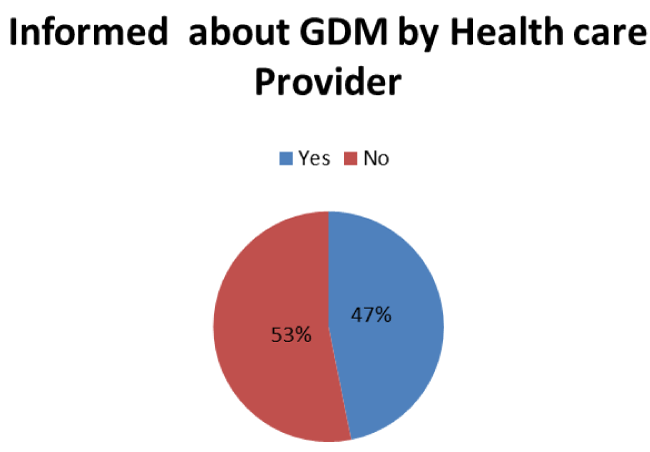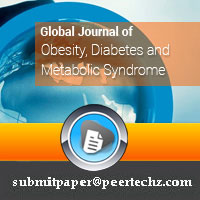Global Journal of Obesity, Diabetes and Metabolic Syndrome
Gestational diabetes awareness in women of childbearing age in Sharjah
Amr Elmekresh*, Batool AbuHalimeh, Rawan Abukhater, Amina Bakro and Samher Nahab
Cite this as
Elmekresh A, AbuHalimeh B, Abukhater R, Bakro A, Nahab S (2017) Gestational diabetes awareness in women of childbearing age in Sharjah. Glob J Obes Diabetes Metab Syndr 4(2): 051-053. DOI: 10.17352/2455-8583.000023Objectives: Gestational diabetes mellitus (GDM) is a current health problem that affects a large number of female population and has deleterious impact on both the mother and the child. The aim of this study is to assess the awareness of GDM among females in the childbearing age in Sharjah community.
Study Design: study is a quantitative “cross-sectional” descriptive. The study subjects have been chosen to represent the population, and all the data will be collected over a specific period of time (3 weeks).
Methods: In this cross-sectional study awareness about GDM in females of general population aged between 18-45 years was assessed. A validated questionnaire was used. Responses were scored from 0-39, a score of 19 indicated awareness. Data was analyzed using Chi-square independent T-test for bivariate analysis, via SPSS21 software.
Results: Four hundred and fifty women participated in the study, of whom 73.5% were aware of the disease. Married women had a higher level of awareness compared to non-married women (M=14.8, 12.44 respectively,); t (390)=2.46, p = 0.01. Awareness between Emirati and non-Emirati wasn’t significant, (M=13.80M=13.01, respectively) ; t (402)=1.00, p = 0.32 , Also a Chi-square test revealed no relationship was found between Age and the level of awareness of GDM , X2 (24, N = 450) = 21.42, p =0.61, as well as no relationship between level of Education obtained and the level of awareness of GDM , X2 (24, N = 450) = 19.92, p =0.70.
Although the physicians and healthcare providers were the source of information about GDM in only 19.4% of the sample, they are still the most preferable method to get knowledge about the disease.
Conclusion: Although the awareness of GDM as a disease in Sharjah community is high, the depth of knowledge was poor.
Introduction
Gestational Diabetes mellitus (GDM) is one of the Subtypes of Diabetes, the prevalence of which is constantly increasing. Approximately 7% of all pregnancies are complicated by GDM, Resulting in more than 200.00 cases annually. The prevalence may range from 1 to 14% of all pregnancies depending on the population studied and the diagnostics test employed [1].
GDM is associated with an increased Risk of pre-eclampsia for mothers in the Antepartum period and a higher Risk of macrosomia, hypoglycemia, Jaundice, Respiratory distress syndrome, polycythemia and hypocalcemia in infants. After delivery, though the glucose levels return to normal, the mother is at a higher risk for type 2 DM, and the child of a women with GDM is at a higher risk for metabolic syndrome [2].
To our Knowledge this is the first Study done to measure the awareness level and Knowledge about GDM in Sharjah Community. The study will determine whether there is a need to implement a health education program in order to increase the awareness about GDM among females in childbearing age.
Methods
This study was conducted in the emirate Of Sharjah on a Random sample of females in the child bearing age (18-45 years old). The subjects were contacted once by one of the students in the Research group at public places. After taking consent, a pre-tested questionnaire was given by the investigator for collection of data. The Research design of the study is” cross-sectional” descriptive. Women excluded from the study are those who don’t understand Arabic or English and those who suffer from Mental or physical disabilities.
The questionnaire was designed to collect data on background characteristics of age, educational level occupation, marital status, parity and then followed by questions focusing on general awareness and source of Knowledge about GDM including the risk factors, clinical picture and Consequences of GDM for both the mother and the child. Each answer was given a score of 1 out of a total of 49. Association between knowledge and age educational status and a previous pregnancy was analyzed by test of proportions and the statistical significance was assessed using independent test.
Results
Four hundred and fifty women participated in the study. The mean age of women was 30 Years old and the Range was (18-45). Majority of the women (54%) were below the age of 26. Married women were more aware than unmarried women (13.8 versus 12.4). Women Who Conceive children before are 2% more aware about GDM than those who didn’t Conceive before. Women who heard about GDM before had a high score of 15.3 compared to 4.03 in those who didn’t.
Overall, 73.5% of the sample has heard about GDM before with a mean score of 15. Age, nationality, education, employment status were not found to be significantly affecting the level of awareness (Table 1).
Regarding the correct knowledge of GDM, the low mean score indicated that the awareness was generally poor. The score of the majority of the populations’ GDM knowledge was graded as “Fair” (30%).The study highlights the urgent need for strategies to spread awareness about GDM in the general population. The scores of the participants were low. This suggests the need for educational interventions to improve the knowledge about GDM.
The major sources of awareness of GDM were reported to be family Members, media and educational centers. However, Doctors and healthcare providers were the source of Information among a lesser proportion (14 %) of women (Figures 1-3).
Health Care professionals are the most preferred Way to get knowledge about GDM among all participants (27.5%) but yet of no statistical Significance if compared to the other methods.
Awareness among married Women is higher than the unmarried ones with a mean score of 13.8 and 12.4 respectively. Women Who Conceive children before are 2% more aware about GDM than those who didn’t Conceive before. Diabetic women had a mean score of knowledge of 18.2 compared to 13.1 in the no diabetics. Women who heard about GDM before had a high score of 15.3 compared to 4. 03 in those who didn’t.
Discussion
Gestational Diabetes is a current health problem that affects a large proportion of the female population and has short and also long-term consequences to both mother and fetus.
Although the prevalence of GDM in Gulf Region is increasing, the actual magnitude of GDM especially in UAE is lacking. In the United Arab Emirates (UAE), previous studies have shown a very high prevalence of GDM in association with maternal obesity and high-order multiparity [3]. The inconsistency in GDM diagnosis is evident in UAE, which has the second highest prevalence of type 2 diabetes (18.7%) in the world [4]. GDM in the UAE varies from 7.9 to 24.9 % depending on which of the six well-accepted criteria are used for diagnosis [5]. However, the Popular American Diabetes Association (ADA) criteria demonstrates a prevalence of 10.6-14.7% [6]. The prevalence of GDM In Saudi Arabia in 2010 was Reported to be 12.5 % in a high parity group of pregnant women and the significant risk factors were obesity, advanced maternal age, low income and female past history of DM [7].
In a large Retrospective study of 49552 pregnant women in Bahrain, the Average incidence of GDM rose from 7.2% in 2002 to 12.5% in 2010, which is much higher than the last published value of 5.4% in 1989. Such gradual increase in the last 9 years is alarming and provides an indicator of the future burden on health Care in Bahrain [8].
This study shows that a great proportion of the Women (73.5%) were aware of the GDM. Awareness was higher among married Women and those who had previous pregnancy or diabetes mellitus.
However, Knowledge about the risk Factors for GDM, as genetic factors, obesity, Diet and Maternity age was not as high as expected. The healthcare providers were quoted as a source of information by only 19.4 % of the women whiles the rest got it from the Mass media or other sources. The physicians have to educate the healthcare providers and both of them have to play a greater role in raising the awareness among antenatal women. The topic of GDM should be included in the healthcare education programs.
Conclusion
Although the awareness of GDM is Sharjah community is high, yet more efforts are necessary to implement a health educational program to improve the knowledge about the risk factors, course, and effects of GDM on the women, as a higher level of awareness will improve pregnancy outcomes.
Ethical Considerations
An informed consent will be attached with the questionnaire, to inform the participants about the whole procedure that will be done during the data collection process. The consent will assure the participants that confidentiality of all the information given will not be breached. The questionnaire is consistent of 30 questions discussing our objective and research questions. The participants have the right to withdraw anytime they want, and their questionnaires will be cancelled.
- Shriraam V, Rani MA, Sathiyasekaran BWC, Mahadevan S (2013) Awareness of gestational diabetes mellitus among antenatal women in a primary health center in south India. Indian J Endocrinol Metab 17: 146-148. Link: https://goo.gl/H3ZbXR
- Kjos SL, Buchanan TA (1999) Gestational diabetes mellitus. N Engl J Med 56: 341. Link: https://goo.gl/hupHJR
- Hughes PF, Agarwal M, Newman P, Morrison J (1995) Screening for gestational diabetes in a multi-ethnic population. Diabetes Res Clin Pract 28: 73-78. Link: https://goo.gl/hUyypX
- International Diabetes Federation (2009) Diabetes e-Atlas. Brussels, Belgium.
- American Diabetes Association (2010) Diagnosis and classification of diabetes mellitus (Position Statement). Diabetes Care 33: S62-S69). Link: https://goo.gl/NyFm2K
- Agarwal MM, Dhatt GS, Othman Y, Gupta R (2009) Gestational diabetes: fasting capillary glucose as a screening test in a multi-ethnic, high- risk population. Diabetes Medicine 26: 760-765. Link: https://goo.gl/AnxaeD
- Al-Rowaily MA, Abolfotouh MA (2010) Predictors of gestational diabetes mellitus in high-parity community in Saudi Arabia. East Mediterr Health J 16: 636-641. Link: https://goo.gl/EXttXS
- Rajab KE, Issa AA, Hasan ZA, Rajab EB, Jaradat AA (2011) Incidence of gestational diabetes mellitus in Bahrain from 2002 to 2010. International Journal of Gynecology and Obstetrics 117: 74-77. Link: https://goo.gl/Cc2o2z
Article Alerts
Subscribe to our articles alerts and stay tuned.
 This work is licensed under a Creative Commons Attribution 4.0 International License.
This work is licensed under a Creative Commons Attribution 4.0 International License.




 Save to Mendeley
Save to Mendeley
